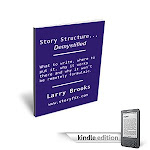Recently I went through a critique session with some of my new colleagues from the RCRW. I must say that it was an eye opening experience. First of all, I'd like to mention that I've found myself among a group of extremely talented people. The pieces of work that I read were positively amazing! While I think that everyone in the group shows promise, there is one writer in particular that I honestly believe will be among published authors within the next few years and I will be happy to say that she slashed my work to shreds :).
Having other people critique your work is incredibly helpful. I gained incredible insight into my work that I would have never seen myself, and this has helped me to improve upon what I have already written. Besides many annoying quirks that I have that I can now avoid, thanks to their comments, I have also found that I am prone to information dumps. A few people have pointed this out, but I think now I get it.
Now here's my thought on information dumps. They aren't bad. Okay - WAIT! Before you start getting your panties in a twist, let me finish. If you are a pantser like me (someone who writes by the seat of her pants and then goes back and figures out what to do with it), they are akin to the character interviews that more structured individuals like to partake in. The information dumps are a great way to learn about the characters pasts. To really get close to the character and understand what your characters think and what motivates them. However - it is also important to recognize them as information dumps. My information dumps have become very structured (yay W). Thanks to the many books, conferences, and classes I have participated in, I have learned how to structure a scene. My information dumps have a goal, they accomplish what they should, the characters are doing what they are supposed to be doing - but here's the key, they contain information that the reader does not need to know. Sure, the information may be interesting, it may be some of the best writing in the book, but if it doesn't advance the overall goal of the character (not the scene goal - the overall goal), then the reader just doesn't need to know.
I think the key is, knowing when to dump your dumps. As long as you can distinguish when the scene advances the goal, and when it is something that you wrote for your own benefit - then information dumps can be a very positive thing. One man's trash....







